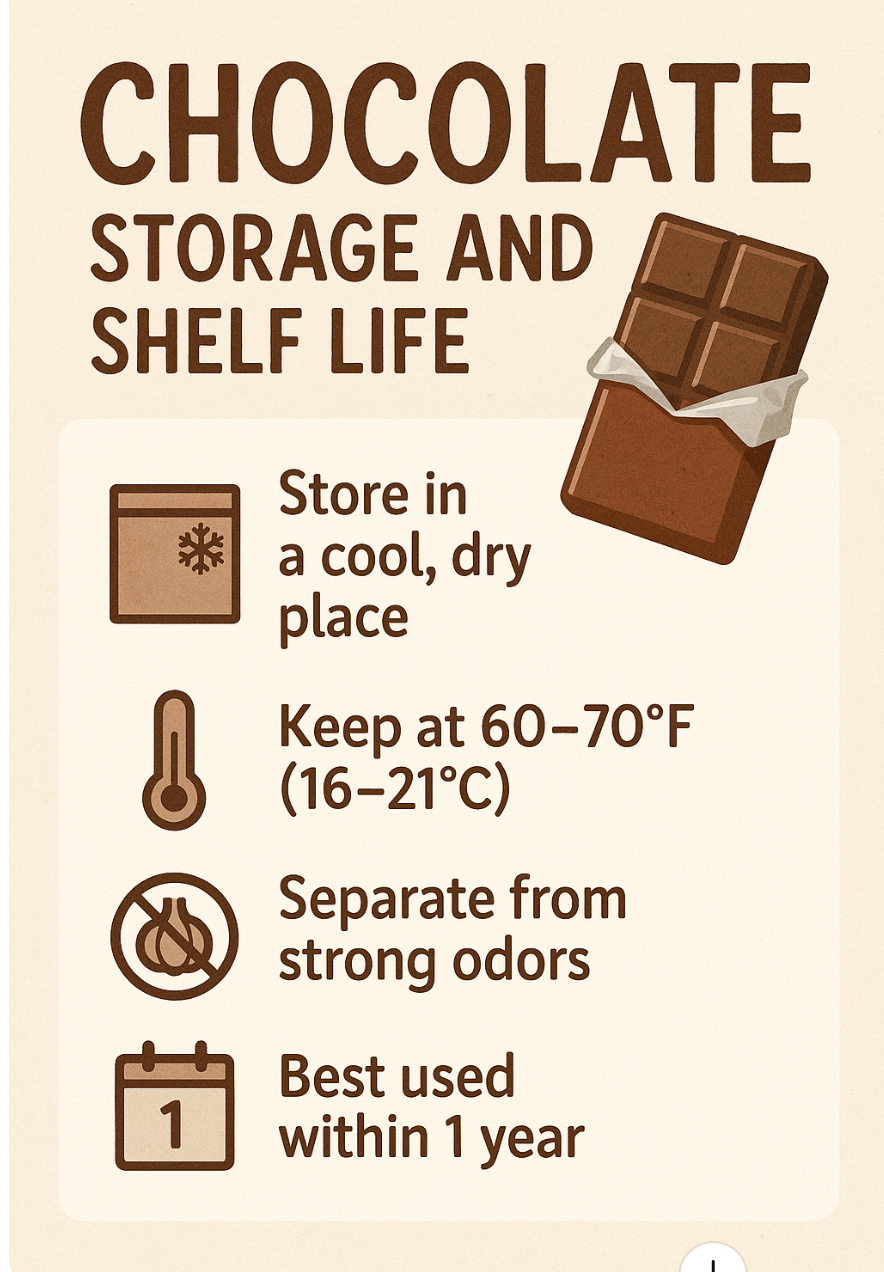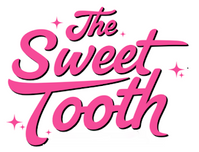
How Long Does Chocolate Stay Fresh? Your Complete Storage Guide
Quick Answer: Dark chocolate stays fresh for 18-24 months, milk chocolate lasts 6-12 months, and white chocolate keeps for 4-6 months when stored properly. The key is keeping chocolate in a cool, dry place at 60-70°F.
Understanding Chocolate Shelf Life
Chocolate lovers often ask: does chocolate expire? The good news is that chocolate has an impressive shelf life compared to most treats. Unlike perishable foods, chocolate contains minimal water, which means bacteria can't easily grow and thrive on it.
How Long Different Types of Chocolate Last
Dark Chocolate
Dark chocolate is the champion of longevity. High-quality dark chocolate with 70% cocoa or higher can stay fresh for 18 to 24 months at room temperature. The higher cocoa percentage actually works in your favor—cocoa butter is naturally stable, while additional ingredients like milk solids are more prone to deterioration.
Milk Chocolate
Milk chocolate typically stays fresh for 6 to 12 months when unopened and stored correctly. The dairy content makes milk chocolate more susceptible to spoilage than dark varieties, so it has roughly half the shelf life of its darker cousin.
White Chocolate
White chocolate has the shortest shelf life of all. It can last up to 4 to 6 months unopened under ideal conditions. Since white chocolate contains cocoa butter, milk solids, and sugar but no cocoa solids, it's more vulnerable to going rancid quickly.
Filled Chocolates and Truffles
Got chocolate truffles or filled chocolates? These premium treats will remain at peak quality for only 2 to 4 months at room temperature. Fillings like cream, caramel, and nuts reduce shelf life significantly compared to solid chocolate bars.
What Happens After the Best-By Date?
Here's something important to know: chocolate has a "best by" date instead of a "sell by" date. This means you can safely enjoy chocolate for months past the printed date if it's been stored properly and shows no signs of spoilage.
How to Store Chocolate Properly
The Ideal Storage Location
Store chocolate at temperatures between 60°F and 70°F in a cool, dry place. Your pantry or kitchen cupboard away from the stove works perfectly. Humidity should be kept below 50-55% to prevent sugar bloom.
Should You Refrigerate Chocolate?
Generally, no. Chocolate easily absorbs odors from the refrigerator, and moisture can lead to sugar bloom. Your chocolate might end up tasting like last night's leftovers—not exactly what you want.
However, refrigeration can work if:
- You live in a very hot climate without air conditioning
- Summer temperatures regularly exceed 75°F
- You need to extend shelf life beyond the typical window
If you must refrigerate chocolate, wrap it tightly to protect against odors and condensation, then seal it in an airtight container. When removing it, let it return to room temperature before unwrapping.
Freezing Chocolate for Long-Term Storage
For storage durations of 6 months to a year, the freezer can be your friend. Follow these steps:
- Wrap chocolate tightly in plastic wrap
- Place in an airtight freezer-safe container
- Refrigerate for 24 hours first to avoid temperature shock before moving to the freezer
- When thawing, move from freezer to fridge for 24 hours, then to room temperature while still wrapped
Keep Chocolate Away From
- Direct sunlight: UV rays can cause off-flavors and damage chocolate quality
- Strong odors: Chocolate absorbs nearby odors like a sponge
- Moisture: High humidity causes sugar bloom
- Heat sources: Ovens, stoves, and sunny windowsills
- Open air: Oxygen exposure causes oxidation and off-flavors
Understanding Chocolate Bloom
Have you ever opened a chocolate bar to find a white, dusty coating on the surface? Don't panic—it's probably chocolate bloom, and it's completely safe to eat.
Fat Bloom
Fat bloom appears as grayish or whitish streaks on the chocolate surface that feel slick to the touch. It happens when chocolate is exposed to warm temperatures, causing the cocoa butter to soften, separate from other ingredients, rise to the surface, and re-solidify.
Sugar Bloom
Sugar bloom is characterized by a white, dry, grainy coating that occurs when chocolate is exposed to moisture. The moisture dissolves surface sugar, which then recrystallizes when the moisture evaporates.
How to Tell Them Apart
With fat bloom, a water droplet will bead up on the surface since fats repel water. With sugar bloom, the droplet quickly flattens and spreads as it dissolves the sugar crystals.
Is Bloomed Chocolate Safe?
Absolutely. Fat and sugar bloom damage the appearance of chocolate but do not limit its shelf life or make it unsafe to eat. The texture and taste might be slightly off, but bloomed chocolate is perfect for baking or any recipe requiring melted chocolate.
Signs Your Chocolate Has Gone Bad
While chocolate rarely "goes bad" in the traditional sense, here's when you should toss it:
- Bad or odd odors: Any unpleasant smell indicates spoilage
- Mold: If you see any fuzzy growth, throw it away
- Unusual taste: Rancid or stale flavors mean it's past its prime
- Multiple cracks on the surface: Surface cracks indicate the chocolate is stale and past its prime
White spots alone are not a reason to discard chocolate—that's just bloom, which is harmless.
Special Storage Tips
For Chocolate with Nuts or Fillings
Candies with nuts or other ingredients like Snickers bars or Reese's peanut butter cups are more prone to going bad at a quicker rate. Check these more frequently and consume them within their recommended timeframe.
For Baking Chocolate
Dark baking chocolate, semi-sweet, and bittersweet varieties follow the same rules as regular dark chocolate—they can last 1.5 to 2 years when stored properly.
For Opened Chocolate
Once a package is opened, cut the shelf life in half: one year for solid dark chocolate and six months for solid milk chocolate. Place opened boxes in a heavy-duty plastic bag or airtight container and seal tightly.
Factors That Affect Chocolate Freshness
Temperature Fluctuations
Extreme temperature fluctuations can be particularly damaging, causing sugar bloom and altering chocolate's texture. Consistency is key—avoid moving chocolate between hot and cold environments.
Humidity Levels
The ideal humidity for chocolate storage is below 50%. Bathrooms, kitchens near the sink, and basements with moisture issues aren't ideal storage spots.
Light Exposure
Chocolate, especially milk and white varieties, is sensitive to light. Store in opaque containers or keep chocolate in its original wrapper to protect it from UV damage.
Oxygen Exposure
Keep chocolate tightly wrapped or in airtight containers to prevent oxidation, which can cause off-flavors and reduce quality over time.
Maximum Freshness Tips
- Buy fresh: Purchase from reputable suppliers who store chocolate properly
- Check dates: Look for the furthest-out best-by dates when shopping
- Buy appropriate quantities: Only purchase what you'll consume within the optimal freshness window
- Use proper containers: Airtight containers are your best friend
- Monitor storage conditions: Keep an eye on temperature and humidity in your storage area
- First in, first out: Use older chocolate before opening new packages
Can You Revive Old Chocolate?
While you can't completely reverse aging, bloomed chocolate can be re-tempered by melting and properly tempering it again. This works best for baking and cooking purposes rather than eating plain chocolate bars.
Bottom Line
Chocolate is remarkably long-lasting when stored correctly. Dark chocolate can stay delicious for up to two years, while milk and white chocolate have shorter lifespans. The keys to maximum freshness are simple: keep chocolate in a cool, dry place between 60-70°F, protect it from moisture and odors, and store it in airtight containers.
Even if your chocolate develops bloom or passes its best-by date, it's likely still safe to eat—though it may not taste quite as amazing. When in doubt, trust your senses: if it looks, smells, and tastes like chocolate should, you're good to go. If there are strange odors, mold, or off-flavors, it's time to say goodbye.
Remember, proper storage not only extends shelf life but also preserves that wonderful taste and texture that makes chocolate so irresistible. Treat your chocolate right, and it'll treat your taste buds right in return.
For more chocolate tips, recipes, and guides, visit TheSweetTooth.com—your ultimate resource for all things sweet!
